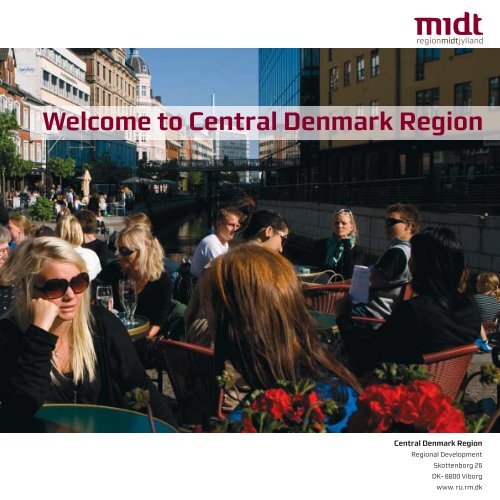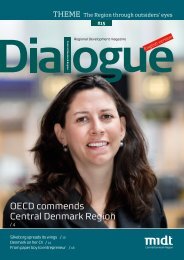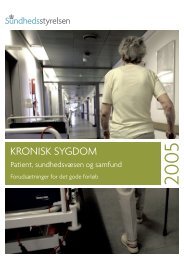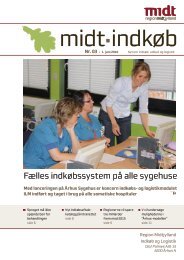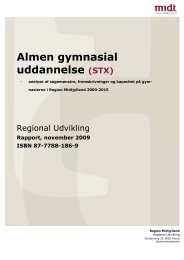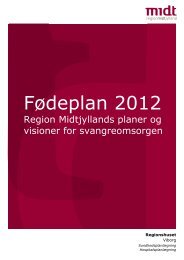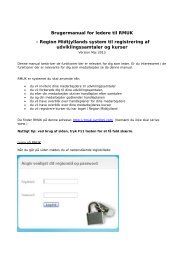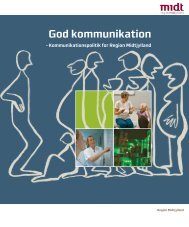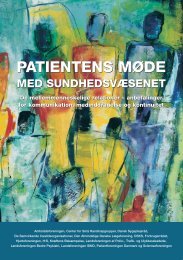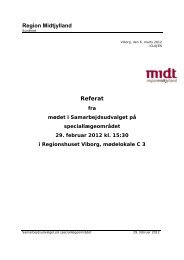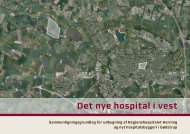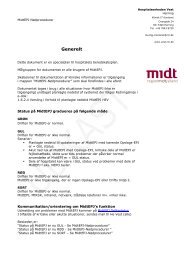Welcome to Central Denmark Region
Welcome to Central Denmark Region
Welcome to Central Denmark Region
- No tags were found...
Create successful ePaper yourself
Turn your PDF publications into a flip-book with our unique Google optimized e-Paper software.
<strong>Welcome</strong> <strong>to</strong> <strong>Central</strong> <strong>Denmark</strong> <strong>Region</strong><strong>Central</strong> <strong>Denmark</strong> <strong>Region</strong><strong>Region</strong>al DevelopmentSkottenborg 26DK- 8800 Viborgwww. ru.rm.dk
12 34
<strong>Welcome</strong> <strong>to</strong> <strong>Central</strong> <strong>Denmark</strong> <strong>Region</strong>, thelargest of the five Danish regions – covering13,000 square kilometres. The regionhas a population of 1.2 m people. Thereare landscapes and cultural sights <strong>to</strong> suitevery taste all the year round. The regionalso has a thriving business communitywith specific strengths within sustainableenergy production, processing of foodstuffs,information technology and advancedmanufacturing industry.In addition, the university and researchfacilities are of a high international standard.The region is well served by a digital andphysical infrastructure that covers highwaysas well as two international airports and<strong>Denmark</strong>’s largest container harbour.The region stretches from coast <strong>to</strong> coastacross <strong>Central</strong> Jutland Peninsula. It offersa wide range of experiences. From theuntamed North Sea in the West with endlesskilometres of sandy beaches for nature lovers,swimmers, windsurfers and kite surfers <strong>to</strong>the hilly lake district in the heart of Jutlandwith its Himmelbjerget and on <strong>to</strong> city life inÅrhus, the second largest city in <strong>Denmark</strong>.Djursland lying even further <strong>to</strong> the East has awide variety of landscapes and presents threeexperience centres with marine, domestic andexotic animals.Come and see a part of <strong>Denmark</strong> where aninteresting experience is never more than ashort walk away – whether you are a <strong>to</strong>urist, abusiness traveller, an international partner, ascientist or a student.1 The highest points of <strong>Denmark</strong> are <strong>to</strong> be found inthe <strong>Central</strong> <strong>Denmark</strong> <strong>Region</strong>. One of them beingHimmelbjerget close <strong>to</strong> Silkeborg with its 147metres. Though not particularly high, it is a verypopular destination because of its highly attractivesurroundings.The monument at the <strong>to</strong>p was erectedby the Danish people in 1849 <strong>to</strong> commemorateKing Frederik VII’s decision <strong>to</strong> grant them their freeconstitution.2. The Danes call the part of the North Sea closest <strong>to</strong> thewestern coast of <strong>Denmark</strong> “Vesterhavet” (WesternSea). There are endless, white sandy beacheswhich are freely accessible <strong>to</strong> all. In fair weatherVesterhavet is a paradise for sunbathers, swimmers,windsurfers and anglers, and not forgetting buildersof sandcastles. At other times, Vesterhavet can beferocious with meter high waves crashing on<strong>to</strong> thebeach – <strong>to</strong> the delight of those who revel in the forcesof nature – and later for those who like <strong>to</strong> hunt for thecoveted lumps of amber thrown up upon the shore.3. If you are interested in marine life, a visit <strong>to</strong> TheKattegat Centre is a must. Situated close <strong>to</strong> GrenåHarbour on the eastern coast of Jutland this giant saltwater aquarium contains tropical sharks, seals, rays,jellyfish and a wealth of other sea creatures.4. Djursland in the very East of the region offers a widevariety of landscapes, lush nature, beautiful sceneryand gorgeous deciduous woodlands inviting <strong>to</strong> hikingand picnicking. From Djursland there is a ferry <strong>to</strong>the Isle of Anholt which boasts the only desert inNorthern Europe as well as a rich bird and animal life.
Special focus areas in business5 67
The regional administration of <strong>Denmark</strong> iscomprised of five regions. They are primarilyresponsible for the health sec<strong>to</strong>r includinghospitals and general practitioners, butalso the social care and psychiatry sec<strong>to</strong>rs.Also, of major importance is the area of<strong>Region</strong>al Development covering business,education, culture, natural resources, energy,environment and public transportation.Each region has its own Development Forum,which consists of representatives from theregional and municipal level, the businesssec<strong>to</strong>r, the educational institutions and thesocial partners.The 20 members of the forum preparebusiness development strategies and play anactive role in allocating EU structural funds.The Development Forum of <strong>Central</strong> <strong>Denmark</strong><strong>Region</strong> has decided <strong>to</strong> focus particularly oneducation and training, the developmen<strong>to</strong>f skills and competencies, innovationand research as well as entrepreneurialinitiatives. The Development Forum iscontinuously supporting and assisting newinitiatives within the aforementioned focusareas.These initiatives must also have a relation <strong>to</strong>one or more of the following sec<strong>to</strong>rs wherethe region sees itself as being particularlystrong: energy and the environment,health-related business and foodstuffs.The region has world leaders like Vestas,Siemens and Grundfos in the energy andenvironment sec<strong>to</strong>r as well as many smalland medium-sized businesses specialising indeveloping their own products or operatingas sub-contrac<strong>to</strong>rs.The growing political awareness concerningclimate changes and safety of energy supplyhas added pressure on the global market <strong>to</strong>develop efficient and sustainable solutions in5. The <strong>Central</strong> <strong>Denmark</strong> <strong>Region</strong> is especially strong inthe energy and environment sec<strong>to</strong>r. New initiativesfocusing on sustainability are launched every year.The world’s largest test plant of biogas was openedin Oc<strong>to</strong>ber 2007 at Research Centre Foulum eas<strong>to</strong>f Viborg. The purpose being <strong>to</strong> improve utilisationof biogas as well as lessening the impact on theenvironment and climate.6. In Brædstrup near Horsens 8,000 square metres arecovered with solar panels that produce inexpensivepower and sustainable heating for the local districtheating consumers. This plant is the largest in theworld and with support from <strong>Central</strong> <strong>Denmark</strong><strong>Region</strong> among others it will begin experimentingwith providing sustainable energy <strong>to</strong> a future, largehousing estate.7. Samsø, the renewable energy island of <strong>Denmark</strong>, hasbeen energy self-sufficient since 2003, this includesoffshore and onshore wind energy turbines. Next stepis a more intelligent use of energy resources.Pho<strong>to</strong>: Samsø Energiakademi.
8910 11
energy and environment technology.The <strong>Central</strong> <strong>Denmark</strong> <strong>Region</strong> has therefore aunique potential for being able <strong>to</strong> develop theenergy and environment technology sec<strong>to</strong>r.The region will have a prominent place in2009 when <strong>Denmark</strong> hosts the UN climateconference. A very unique case is the Danishisland of renewable energy, Samsø, whichhas been self-sufficient in energy since 2003.The next goal, however, is a more intelligentuse of energy resources – e.g. using excesselectricity and hydrogen in the transportsec<strong>to</strong>r.The region sees great development potentialin the health-related business sec<strong>to</strong>r.The research undertaken at the region’seducational institutions is amongst the bestin the world. Based on the health sec<strong>to</strong>r,<strong>Central</strong> <strong>Denmark</strong> <strong>Region</strong> aims <strong>to</strong> furtherdevelop a business which is innovative andglobally oriented. This it aims <strong>to</strong> achieve byincreasing co-operation between businesscommunities, the health and knowledgesec<strong>to</strong>rs and across borders of trade, industryand geography.<strong>Central</strong> <strong>Denmark</strong> <strong>Region</strong> also has a veryimportant foodstuffs sec<strong>to</strong>r with largemanufacturing, processing and distributionunits, strong research and developmentactivities, knowledge groups as well as avariety of networking activities. This sec<strong>to</strong>r in<strong>Central</strong> <strong>Denmark</strong> <strong>Region</strong> comprises of smalland medium-sized manufacturers as well aslarge international companies.8. One of the projects in <strong>Central</strong> <strong>Denmark</strong> <strong>Region</strong>generating new health-related business is thenew University Hospital in Århus. Being the largestreorganisation of existing hospitals ever undertakenin <strong>Denmark</strong> this project offers a unique possibility<strong>to</strong> combine the efforts of researchers, developers,manufacturers and the health care sec<strong>to</strong>r. This willempower and innovate the business sec<strong>to</strong>r as well asprovide the basis for new enterprises. The hospitalis expected <strong>to</strong> be completed over the course of thenext 12-15 years. The new hospital will have an areaof 400,000 square meters, employ 9,000 people andbe able <strong>to</strong> accommodate 100,000 admissions and600,000 out-patient visits annually.Pho<strong>to</strong>: DNU-konsortiet9. Every pig carcass from the Danish Crownslaughterhouse in Horsens is au<strong>to</strong>maticallypho<strong>to</strong>graphed and ultrasound scanned and thenthe first carving is done by robots.Technologyhas provided the employees with a less physicallydemanding job.10. The Centre for Pervasive Healthcare at the AlexandraInstitute in Århus has developed a technology whichmakes it possible for patients with external woundsand ulcers <strong>to</strong> receive remote treatment. This isparticularly relevant for the treatment of elderlydiabetic patients with leg ulcers in their own homes. Avisiting nurse can film the wound with a mobile phoneand the hospital doc<strong>to</strong>r can see it online and planfuture treatment.11. Ejstrupholm Dambrug (fish farm) produces 2,000<strong>to</strong>nnes of rainbow trout a year and uses the mostrecent technology <strong>to</strong> benefit the environment. Thisfarm cleanses, filtrates and recycles its own water nolonger having <strong>to</strong> use water from the nearby stream.
The politicians ruleThe 41 members of the <strong>Region</strong>al Council meet once a month in the regional council hall in Viborg.The circular hall with a diameter of 30 meter is designed by the Danish architectural firm Schmidt Hammer Lassenwhile the artist Birgit Østergaard is behind the ceiling decorations that create a map of the 19 municipalities of the region.
The 41 elected politicians in the <strong>Region</strong>al Council are the highest political authority of the<strong>Region</strong>. Elections for the <strong>Region</strong>al Council are held every four years, with the next due in theautumn of 2009.The council consists of eight parties at present: Socialdemokraterne (the Social Democrats,with 16 seats) and Venstre (<strong>Denmark</strong>’s centre-right Liberal Party,14 seats) as the largestparties followed by Det Konservative Folkeparti (the Conservative People’s Party, 3 seats),Dansk Folkeparti (The Danish People’s Party, 2 seats), Socialistisk Folkeparti (The SocialistPeople’s Party, 2 seats), Kristendemokraterne (The Christian Democratic Party, 1 seat), DetRadikale Venstre (The Danish Social-Liberal Party, 1 seat), Enhedslisten (The Danish Red-Green Alliance, 1 seat) as well as one member without any party affiliation.<strong>Region</strong>al CouncilCorporate ManagementAdministrativeDepartmentDevelopmentForumHealthPsychiatry andSocial Service<strong>Region</strong>alDevelopment<strong>Central</strong> <strong>Denmark</strong> <strong>Region</strong> is one of five administrative units in <strong>Denmark</strong>. The primaryresponsibility of <strong>Central</strong> <strong>Denmark</strong> <strong>Region</strong> is healthcare, involving responsibility forhospital services, including psychiatry, general practitioners and specialist doc<strong>to</strong>rs. Inaddition, the region operates a number of social care institutions. Furthermore, the regionensures and coordinates regional development in areas of nature, environment, business and<strong>to</strong>urism. Approximately 30,000 people are employed at various institutions and organisationsunder the remit of the <strong>Central</strong> <strong>Denmark</strong> <strong>Region</strong>.As shown in the figure above the Development Forum and the <strong>Region</strong>al Development Unit areconnected.
Skive<strong>Central</strong> <strong>Denmark</strong> <strong>Region</strong> covers 19municipalities and is the largest of thefive regions. For more information aboutthe region and its special qualities andactivities, see the following web-address:<strong>Central</strong> <strong>Denmark</strong> <strong>Region</strong>:http://www.rm.dkLemvigStruerViborgRandersNorddjursHolstebroFavrskovSyddjursHerningSilkeborgRingkøbing-SkjernIkast-BrandeSkanderborgÅrhusHorsensOdderSamsøHedensted
Århus is <strong>Denmark</strong>’s second largest city with more than 40,000 students and an internationaleducational environment providing a sound foundation for lively restaurants, cafés and othermeeting places within the city.Grafisk Service · 4100-08-054


